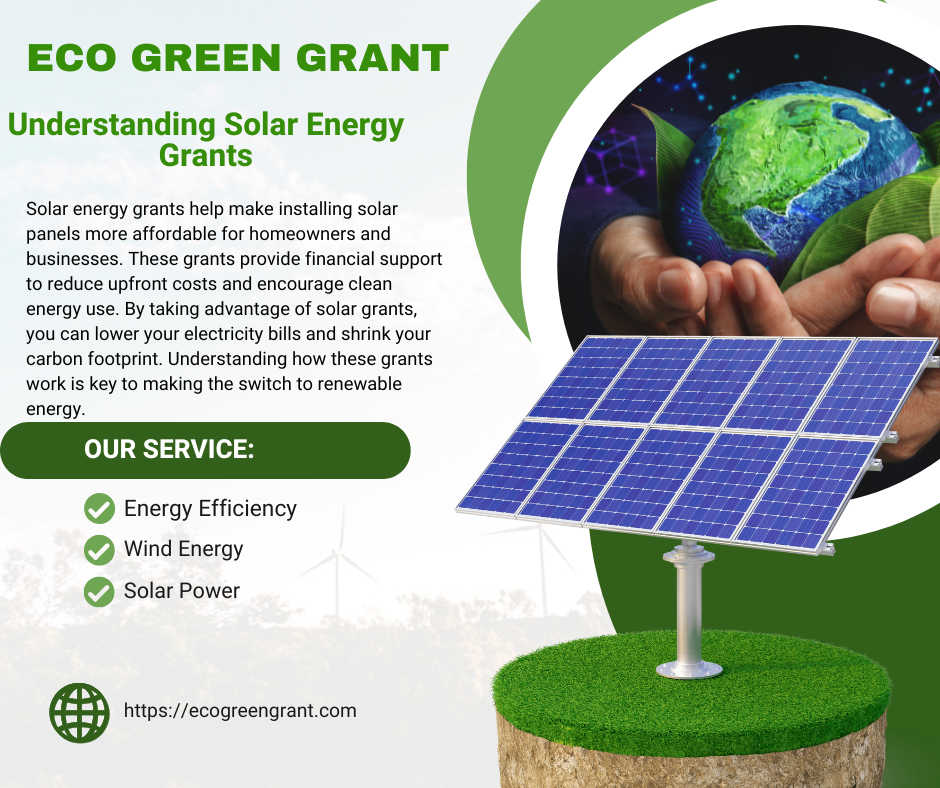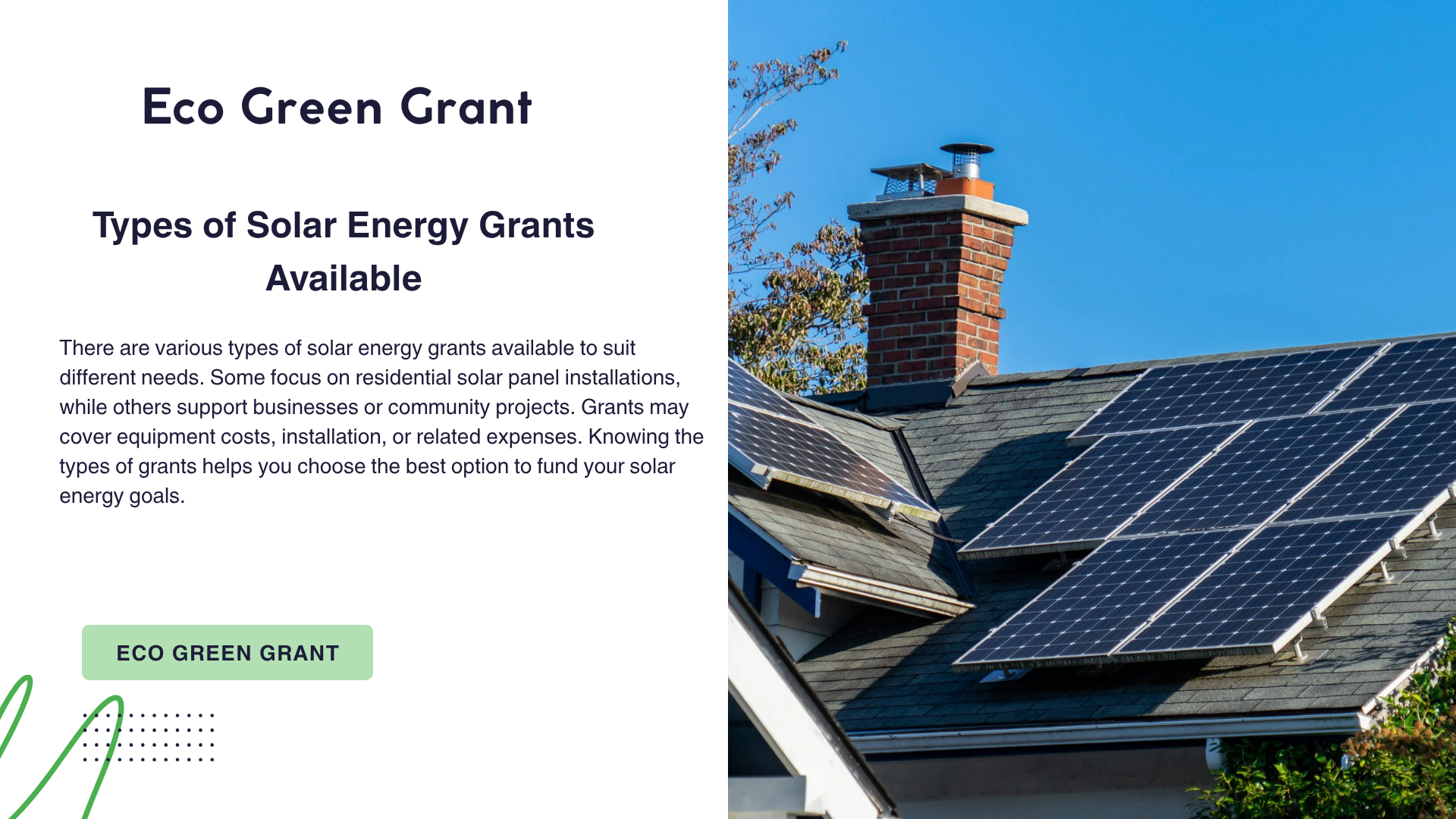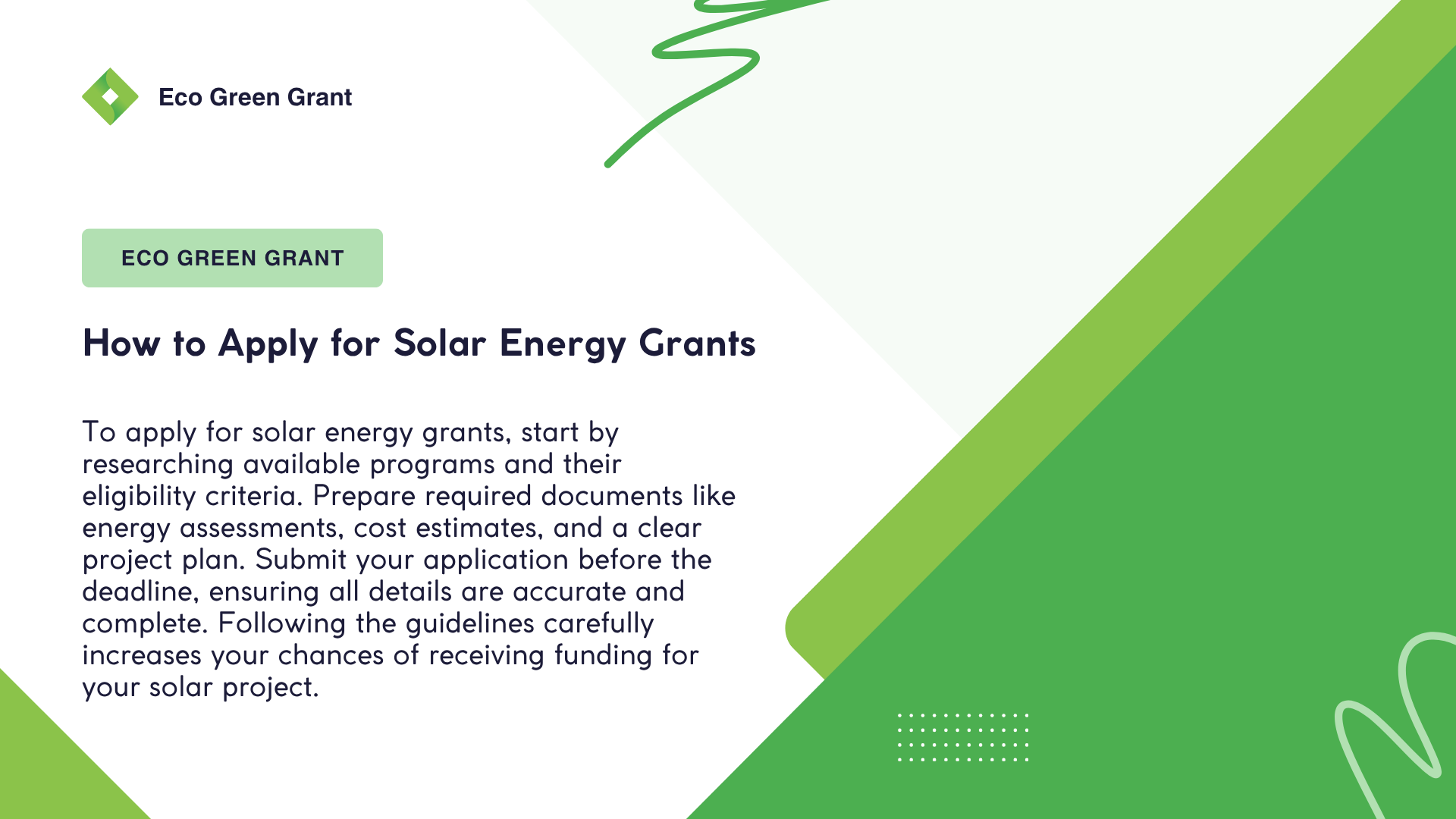Solar energy grants are making it easier than ever to switch to clean energy. Whether you’re a homeowner or a small business, there’s financial support available to lighten the load. Programs like Eco Green Grant are helping everyday folks make the transition. Let’s explore everything you need to know about solar energy grants and how you can benefit today.
Understanding Solar Energy Grants

What Are Solar Energy Grants?
Solar energy grants are financial incentives provided by the government, private institutions, or non-profits to help offset the cost of installing solar panels. These grants don’t need to be repaid, making them an excellent option for anyone wanting to go solar without the burden of high upfront costs. Unlike loans, grants are free money designed to encourage renewable energy adoption across communities. Programs like Eco Green Grant aim to make Solar Panel Funding more accessible to all.
Why Are They Important?
These grants help reduce the reliance on fossil fuels, cutting down carbon emissions and supporting sustainable living. They also help homeowners and small businesses reduce utility costs over time. Solar energy grants are especially helpful in communities where clean energy adoption might be too expensive otherwise. With more financial aid available, more people can take part in the clean energy movement, improving both individual savings and environmental health.
Who Can Apply for Them?
Eligibility varies depending on the program, but most solar energy grants are open to homeowners, small business owners, schools, and sometimes nonprofits. Some local governments offer specialized grants for low-income households or rural residents. Others, like Eco Green Grant, focus on providing support across various regions with simple application processes. Always check the specific requirements before applying to make sure you qualify.
Types of Solar Energy Grants Available

Federal Solar Energy Grants
The U.S. government offers a range of solar energy grants through departments like the Department of Energy (DOE) and the USDA. For example, the Rural Energy for America Program (REAP) helps rural businesses and farms go solar. These grants often pair with tax credits, making solar more affordable. The federal government wants to boost clean energy use nationwide, and Energy Company Obligation schemes are a key tool in this effort.
State and Local Grants
States like California, New York, and Colorado offer generous solar energy grant programs. These often supplement federal grants, helping residents cover more of the cost. Some cities also run their own local programs tailored to their climate goals. For example, the New York State Energy Research and Development Authority (NYSERDA) provides both technical assistance and funding to homeowners and businesses.
Private and Nonprofit Grants
Organizations such as Eco Green Grant and other green energy foundations offer independent solar funding programs. These are often geared toward communities overlooked by larger government initiatives. Nonprofits may focus on low-income families, while private companies might offer grants as part of sustainability campaigns. These sources can fill funding gaps and make a real difference in local adoption rates.
How to Apply for Solar Energy Grants

Research the Right Grant
Start by searching for Solar Energy Grants in your area. Use online tools, contact your local government offices, and check with utility companies. Websites like DSIRE (Database of State Incentives for Renewables & Efficiency) list current programs. Narrow down your list by identifying which grants you’re eligible for and their deadlines. Don’t forget to include private groups like Eco Green Grant in your search.
Prepare Your Documents
Every grant has its own documentation requirements, but most ask for proof of income, property ownership, and a solar installation plan or quote. Some may request energy usage history or environmental assessments. Have your paperwork organized early to avoid delays. Getting a quote from a certified installer can also boost your chances, showing you’re serious about your solar project.
Submit a Strong Application
Be clear and concise in your Application Eco Green Grants. Explain how the grant will help you adopt solar energy and why you need financial help. Use real numbers and timelines where possible. If the application allows, include supporting documents like energy audits or letters of support. Programs like Eco Green Grant often offer help filling out applications or reviewing them before submission.
Benefits of Solar Energy Grants

Lower Upfront Costs
The biggest barrier to installing solar panels is often the cost. Solar energy grants help reduce these expenses, allowing more homeowners to afford clean energy. With grants covering a portion—or sometimes all—of the installation, going solar becomes a realistic option. For example, one family in Illinois used both state and Eco Green Grant funds to install a full solar setup for under $2,000.
Long-Term Energy Savings
Once your panels are installed, you’ll start saving on your monthly electricity bills. Over time, these savings add up, making the initial investment worthwhile. With solar energy grants, your break-even point arrives even sooner. These savings can go toward other home improvements or family needs, turning your energy system into an investment in your future.
Increased Property Value
Homes with solar panels tend to sell faster and at higher prices than those without. Buyers appreciate lower energy bills and eco-friendly upgrades. With the help of a Nottingham Home Upgrade Grant, you’re not only saving money—you’re increasing your home’s market value too. Studies show solar-equipped homes can fetch up to 4% more on the market than non-solar counterparts.
Common Challenges and How to Overcome Them

Finding Available Grants
It can be hard to know where to start. Many people don’t even realize they qualify for solar energy grants. Use online tools and check with local installers who often know what’s currently available. Eco Green Grant also provides updates on open applications and regional programs. Staying informed is the key to not missing out.
Meeting Application Requirements
Some grants have strict criteria—like income limits, rural location, or type of solar system. It’s easy to get discouraged if you feel you don’t meet every box. However, there are many different grants out there, each with its own focus. If you don’t qualify for one, you might for another. Reach out for help from organizations like Eco Green Grant or local nonprofits who can guide you.
Dealing with Red Tape
Government grants often involve a lot of paperwork and waiting. This can be frustrating, especially if you’re eager to get started. Be patient, and don’t be afraid to follow up on your application. Having a detailed plan and timeline will also help you stay on track. Working with experienced solar installers who understand the grant system can simplify the process.
Real-Life Examples of Solar Energy Grant Success
Residential Installations
Meet Sarah, a single mom from Kentucky, who used a state solar energy grant and support from Eco Green Grant to go solar. She cut her monthly utility bill in half and now uses those savings for her kids’ education. Stories like hers show how these programs change lives—not just bank accounts.
Small Business Upgrades
A bakery in Colorado Springs received a local Eco-Friendly Business Grants and installed rooftop panels last year. Not only did their energy costs drop by 60%, but they also gained new customers impressed by their eco-friendly initiative. The bakery now uses its story in its branding and social media, further increasing its reach and revenue.
Nonprofit and School Projects
A middle school in Oregon used a combination of federal and private solar energy grants to install solar panels on campus. The project became a teaching tool for students and a source of pride for the community. With lower energy bills, the school redirected savings into classroom resources and extracurricular programs.
Tips to Maximize Your Solar Energy Grant
Combine Multiple Grants
Many homeowners don’t realize you can stack grants and incentives. You might qualify for a local solar energy grant, a state tax credit, and a federal rebate—all for one project. Eco Green Grant often partners with other organizations to help applicants bundle benefits for maximum savings. Always ask if your chosen grant allows for stacking.
Work with Certified Installers
Using certified, experienced solar installers can improve your grant application. These professionals know what documents are needed and can give accurate project estimates. Some grants even require using pre-approved installers to qualify. Ask for recommendations or search for NABCEP-certified companies in your area.
Stay Informed About New Programs
Solar energy grant options change regularly. New funding rounds open, old ones expire, and eligibility criteria may shift. Sign up for updates from Eco Green Grant and other trusted sources to stay ahead. You don’t want to miss a golden opportunity because you weren’t paying attention.
The Future of Solar Energy Grants
Trends in Green Funding
As climate awareness grows, more funding is being directed toward renewable energy. Expect to see expanded solar energy grant options, especially for low-income and rural residents. Governments and companies alike are pushing for net-zero emissions, and solar plays a big role in that plan. Grants will be essential in achieving these goals.
Role of Eco Green Grant
Eco Green Grant continues to lead the way in offering accessible, transparent solar energy grant options. They focus on community outreach, helping everyday people understand the process and get approved. Their efforts are making a measurable impact across various regions, helping more families and small businesses make the switch.
Making Solar the Standard
With ongoing financial support and increased awareness, solar energy is becoming a standard part of homes and buildings. Solar energy grants are helping us get there faster, making clean energy a realistic choice for more people. As technology improves and prices drop, the grants will remain an important tool for bridging the affordability gap.
FAQs
What are solar energy grants and how do they work?
Solar energy grants are financial incentives that help cover the cost of installing solar panels. These grants are typically offered by governments, nonprofits, or private organizations and do not need to be repaid. They’re designed to encourage the adoption of renewable energy by making it more affordable for homeowners, businesses, and communities.
Who is eligible to apply for solar energy grants?
Eligibility varies depending on the program, but most grants are open to homeowners, small businesses, nonprofits, and sometimes schools or rural farms. Some grants have income or location-based restrictions, while others are more broadly available. Always check the specific criteria of each program to see if you qualify.
How can I find solar energy grants in my area?
You can search for available solar energy grants through online tools like the DSIRE database or contact local government and utility offices. Organizations like Eco Green Grant also provide updates and guidance on current opportunities. Talking to local solar installers can also help uncover lesser-known programs.
What documents do I need to apply for a solar grant?
Most solar energy grants require proof of income, property ownership, a quote from a certified installer, and your recent energy usage history. Some may also ask for an energy audit or a proposed system design. It’s a good idea to gather all these documents before starting your application.
Can I combine multiple solar energy grants and incentives?
Yes, in many cases you can combine local, state, federal, and private grants or rebates. This is known as grant stacking, and it can significantly reduce your out-of-pocket costs. Be sure to check each program’s rules to ensure stacking is allowed. Organizations like Eco Green Grant can help you identify compatible programs.
How long does it take to get approved for a solar energy grant?
Approval times vary by program. Some local grants might approve applications in a few weeks, while federal programs could take a few months. Having your documents ready and a clear project plan can speed up the process. Always check timelines and follow up if you haven’t heard back in a reasonable time.
Are there any costs that grants don’t cover?
Most solar energy grants focus on covering installation and equipment costs. However, they might not cover maintenance, upgrades, or battery storage systems. Some grants only fund a percentage of the total project cost. It’s important to review what is and isn’t covered before you commit.
Will getting a solar grant affect my taxes?
While grants themselves usually aren’t taxable, combining them with federal tax credits like the Investment Tax Credit (ITC) may affect how much you can claim. It’s always best to consult a tax advisor to understand how solar energy grants will impact your taxes, especially if you’re stacking incentives.
What if my solar energy grant application gets denied?
If your application is denied, review the rejection notice to understand why. Sometimes it’s due to missing documents or small errors. You can often reapply or apply for a different program. Reaching out to support teams, such as those at Eco Green Grant, can help you improve your application for the next round.
Are solar energy grants still worth it with falling solar panel prices?
Absolutely. While panel prices have dropped, installation and permitting costs can still be high. Solar energy grants help cover these costs, allowing you to go solar sooner and start saving. Even a small grant can make a big difference in your payback period and overall investment.






